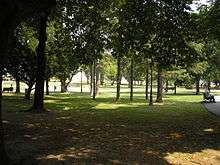Kalemegdan Park

Kalemegdan Park is the largest park and the most important historical monument in Belgrade.[1] It is located on a 125-metre-high (410 ft) cliff, at the junction of the River Sava and the Danube. Its name is formed from the two Turkish words: "Kale" (meaning "fortress") and archaic word of Turkish origin "megdan" (meaning "battlefield").
Kalemegdan Park, split in two as the Large and Little Parks, was developed in the area that once was the town field. It provides places of rest and entertainment. Belgrade Fortress and Kalemegdan Park together represent a cultural monument of exceptional importance, the area where various sport, cultural and arts events take place, for all generations of Belgraders and numerous visitors of the city.
The first works on arranging the town field Kalemegdan started in 1869. During March 1891, the pathways were cut through, and trees were planted; in 1903 the Little Staircase was built, based on the project of Jelisaveta Načić, the first woman architect in Serbia, while the Big Staircase, designed by architect Aleksandar Krstic, was built in 1928.
The Little and Large Kalemegdan Park are as follows:
- Mali Kalemegdanski park (Мали Калемегдански парк or "Little Kalemegdan Park") occupies the area in the eastern section, which borders the urban section of Belgrade. Northern section of Little Kalemegdan Park is occupied by the Belgrade Zoo, opened in 1936. The art pavilion Cvijeta Zuzorić is also located here.
- Veliki Kalemegdanski Park (Велики Калемегдански парк or "Large Kalemegdan Park") occupies the southern corner of the fortress, with geometrical promenades, a military museum, a museum of forestry and hunting, and the Monument of Gratitude to France.
Gallery
-
Monument of Gratitude to France
-

View of park
-

Trees
-

Walkway
